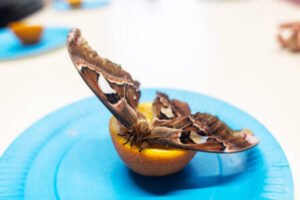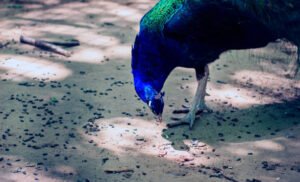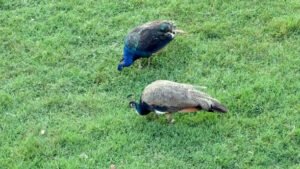
The peacock, renowned for its glorious plumage and regal demeanour, symbolises beauty and harbours intriguing preferences regarding sustenance. In this exploration, we delve into the culinary inclinations of these majestic birds, unravelling the mystery behind their five favourite foods. Peacocks, scientifically classified as members of the pheasant family, are omnivores with a diverse palate that reflects their adaptability to various habitats. Beyond their striking appearance, understanding their dietary preferences unveils a fascinating aspect of their behaviour and ecology.
One of the peacock’s cherished delights is grains. In the wild, they are often spotted foraging for seeds, grains, and small insects, showcasing an eclectic taste encompassing plant and animal matter. The consumption of grains provides them with essential nutrients and underscores their adaptability to different environments.
Additionally, the peacock exhibits a penchant for fruits, relishing their sweetness and nutritional richness. From fallen berries to ripe fruits, these birds savour a cornucopia of nature’s offerings. The significance of fruits in their diet extends beyond mere gustatory pleasure, contributing vital vitamins and antioxidants. While grains and fruits constitute a substantial part of their diet, peacocks are not averse to small reptiles and insects. This carnivorous inclination supplements their nutritional intake, especially with proteins and fats crucial for their overall health and vibrant plumage.
Join us on a captivating journey as we unravel the gastronomic preferences of the peacock, shedding light on the intricate interplay between their diet, behaviour, and the ecosystems they inhabit. In exploring the five favourite foods of these avian marvels, we gain valuable insights into the intricacies of their existence and the delicate balance of nature they navigate.
Insects
Peacocks, the epitome of grace and beauty, exhibit a diverse and fascinating dietary palette that extends beyond the typical image of a seed-eating bird. One of the intriguing facets of their diet revolves around their preference for insects. In this exploration, we delve into the captivating realm of the peacock’s culinary preferences, explicitly focusing on their consumption of insects.

In the wild, peacocks showcase their omnivorous nature by actively seeking out insects as a significant component of their diet. The allure of insects lies in their abundance and the nutritional value they offer to these magnificent birds. Peacocks are opportunistic foragers, and their inclination towards insects is a testament to their adaptability and the evolutionary advantages derived from such dietary diversity.
Peacocks are fond of insects, ranging from small beetles to crawling arachnids. Feeding insects provides peacocks with essential proteins and fats crucial for their overall health and vitality. Protein, in particular, plays a pivotal role in supporting the growth and maintenance of their vibrant plumage, a defining characteristic that contributes to their allure and aesthetic appeal. One notable insect in the peacock’s menu is the beetle. These colourful birds are adept at foraging for beetles in grassy areas, showcasing their keen eyesight and agility in capturing moving prey. Beetles, rich in protein and other nutrients, become a valuable resource for peacocks, aiding in meeting their dietary requirements.
Furthermore, the peacock’s diet may include various species of caterpillars and larvae. Their discerning palate allows them to target these protein-packed sources, contributing to the birds’ overall nutritional balance. The consumption of caterpillars also reflects the peacock’s role in the ecosystem, as they help control insect populations, showcasing a delicate balance in the intricate web of nature.
Interestingly, peacocks also engage in the consumption of spiders and other arachnids. This behaviour highlights their adaptability in exploring diverse food sources within their ecosystem. While not exclusive insectivores, including insects in their diet underscores the dynamic nature of peacocks as opportunistic feeders, capable of adjusting their dietary preferences based on seasonal and environmental factors.
In captivity, providing a diet that includes insects is essential for the health and well-being of peacocks. Breeders and caretakers often supplement their diet with mealworms, crickets, and other insect varieties to ensure these birds receive a well-rounded nutritional profile. This practice mirrors their natural behaviour and helps maintain their physical condition, providing the vibrancy of their plumage and overall vitality.
The peacock’s affinity for insects adds a layer of complexity to our understanding of these magnificent birds. Beyond their striking appearance and elegant courtship displays, their dietary preferences, particularly the consumption of insects, reveal a nuanced aspect of their ecological role and adaptability. By embracing a diverse menu that includes insects, peacocks navigate the intricate tapestry of their natural habitat, showcasing the interconnectedness of all living organisms in the grand symphony of the natural world.
Seeds
In the intricate dance of nature, peacocks, with their glorious plumage and regal demeanour, unveil a captivating aspect of their dietary preferences seeds. As we explore the culinary landscape of these magnificent birds, the consumption of grains emerges as a pivotal element in understanding their nutritional needs, ecological role, and the delicate balance they maintain in their natural habitats.

Peacocks, classified as omnivores, showcase a diverse palate with an evident fondness for seeds. This inclination towards origins is not merely a gustatory preference but a key element in their foraging behaviour and contributes significantly to their overall health. Sources, ranging from grains to small nuts, form a substantial part of the peacock’s diet, revealing a delicate interplay between their dietary choices and the ecosystems they inhabit.
In the wild, peacocks exhibit remarkable foraging skills as they traverse their habitats in search of seeds. Open grasslands and wooded areas become rich grounds for their quest, with peacocks often spotted pecking at the bottom to extract seeds from grasses and fallen vegetation. This foraging behaviour is a means of sustenance and a dynamic display of their adaptability to diverse environments. One of the primary seeds in the peacock’s culinary repertoire is grains. Whether scattered on open grounds or nestled within grassy patches, peacocks can locate and consume grains. This preference for grains aligns with their omnivorous nature, as grains provide essential carbohydrates, fibre, and a variety of micronutrients vital for their well-being.
The significance of seeds in the peacock’s diet extends beyond nutritional considerations. Roots serve as a readily available and energy-dense food source, crucial for sustaining the energy demands of these birds, particularly during mating seasons and periods of heightened activity. The adaptability of peacocks in incorporating seeds into their diet reflects their resourcefulness in utilizing the varied offerings of their habitats.
Furthermore, the peacock’s interaction with seeds contributes to the ecological balance of its environment. As they forage for seeds, peacocks inadvertently participate in seed dispersal, a vital environmental service. Seeds consumed by peacocks may be transported to new locations through excretion, promoting plant growth and biodiversity in different areas.
In captivity, caretakers and breeders often provide a diet rich in seeds to ensure the well-being and vibrancy of peacocks. This practice mirrors their natural behaviour and emphasizes understanding their dietary preferences for practical conservation efforts. The peacock’s affection for seeds provides a nuanced glimpse into the intricate relationship between these birds and their surroundings. From the vast expanses of the wild to the confines of captivity, the consumption of seeds is a thread that weaves through the tapestry of their existence, highlighting the adaptability, resourcefulness, and ecological significance of these iconic avian beings.
Berries
As we continue exploring the culinary world of peacocks, another facet of their diverse diet comes to the fore—their fondness for berries. These vibrant and succulent fruits, scattered across the landscape like nature’s jewels, hold a special place in the peacock’s gastronomic preferences. In this segment, we unravel the significance of berries in the peacock’s diet, examining the nutritional benefits, foraging behaviours, and ecological implications of their indulgence in these colourful treats.

With their rich hues and natural sweetness, Berries become a delectable addition to the peacock’s menu. Whether nestled in bushes or scattered on the forest floor, peacocks exhibit a discerning eye as they forage for these tiny, nutrient-packed treasures. The consumption of berries serves not only as a sensory delight for these birds but also as a source of essential vitamins, antioxidants, and dietary fibre.
One of the key attractions for peacocks in the berry category is the variety of flavours and textures they encounter. From sweet and juicy to tart and pulpy, different types of berries contribute to a diversified diet, enriching the peacock’s nutritional intake. Blueberries, raspberries, and blackberries, among others, become a flavorful ensemble that complements their omnivorous tendencies. The nutritional profile of berries aligns with the peacock’s dietary requirements. These fruits are rich in vitamins, particularly vitamin C, which is crucial to immune function and overall health. Antioxidants in berries neutralise free radicals, protecting against oxidative stress. Additionally, the dietary fibre in berries aids digestion, contributing to the overall well-being of these majestic birds.
Foraging for berries is not merely a culinary endeavour for peacocks; it is a dynamic display of their adaptability to diverse habitats. Woodlands, meadows, and even cultivated areas become foraging grounds as peacocks use their keen eyesight and agile movements to navigate through vegetation in search of these nutritional gems. This foraging behaviour showcases the birds’ ability to integrate seasonal variations into their diet, highlighting the flexibility that defines their omnivorous nature.
Beyond the gastronomic pleasure and nutritional benefits, the peacock’s interaction with berries carries ecological significance. Peacocks inadvertently contribute to seed dispersal as they forage for and consume berries. Seeds consumed with the fruit are later dispersed through their excretion, aiding in plants’ natural regeneration and maintaining biodiversity in their ecosystems.
In captivity, providing a well-rounded diet that includes berries is essential for the health and vibrancy of peacocks. Caretakers often offer a mix of fresh and, when necessary, frozen berries to mimic the diversity they would encounter in the wild. This practice ensures their nutritional needs are met and enriches their captive environment. The peacock’s delight in berries transcends mere gustatory pleasure. It is a multifaceted aspect of their existence that intertwines with their health, behaviour, and ecological role. Through their interaction with nature’s jewels, peacocks illuminate the intricate connections between their dietary choices and the harmonious dance of life in the ecosystems they inhabit.
Small Reptiles
The enchanting realm of the peacock’s dietary choices, including small reptiles, adds a predatory dimension to their omnivorous lifestyle. Beyond the kaleidoscope of feathers and courtship displays, peacocks reveal a penchant for hunting small snakes. This behaviour contributes to their nutritional needs and underscores their adaptability as opportunistic feeders in diverse ecosystems.

Small reptiles, including lizards and amphibians, feature prominently in the peacock’s culinary repertoire. This carnivorous inclination adds a layer of complexity to their diet, as these birds showcase a remarkable ability to balance their intake between plant matter, insects, and vertebrate prey. This predatory behaviour is a testament to their adaptability and a strategic means of acquiring essential nutrients, particularly proteins and fats.
With their keen eyesight and agile movements, Peacocks engage in a deliberate hunt for small reptiles in their natural habitats. Grasslands, shrubbery, and woodland areas become hunting grounds as peacocks use their intelligence and predatory instincts to capture these elusive prey. This behaviour satiates their nutritional requirements and reflects the evolutionary advantages of incorporating small reptiles into their diet.
Small reptiles’ nutritional significance lies in their rich protein content. Proteins are essential for developing and maintaining the peacock’s striking plumage, a hallmark of their visual allure. Including small vertebrates in their diet becomes particularly crucial during specific life stages, such as breeding seasons, when the demand for nutrients is heightened to support courtship displays and reproductive success. While small reptiles form a distinct part of the peacock’s diet, their consumption also serves an ecological purpose. Peacocks, by preying on small reptiles, contribute to regulating local reptile populations. This predator-prey dynamic is a crucial aspect of the delicate balance within ecosystems, preventing the overpopulation of certain species and promoting biodiversity.
In captivity, replicating the peacock’s natural diet, including small reptiles, requires careful consideration. Breeders and caretakers may provide alternative protein sources, such as mealworms or small feeder insects, to meet the nutritional requirements and mimic the diverse diet these birds would have in the wild. This practice not only supports their health but also acknowledges the predatory aspect of their nature.
The peacock’s fascination with small reptiles offers a captivating glimpse into the intricacies of their dietary preferences. Beyond the aesthetics and courtship rituals, including vertebrate prey underscores peacocks’ adaptability and ecological role as dynamic contributors to the delicate tapestry of nature. Their predatory palette, characterized by the pursuit of small reptiles, reflects the multifaceted nature of these iconic birds and their integral place in the ecosystems they call home.
Plants
A verdant tapestry emerges as we traverse the vibrant landscape of the peacock’s culinary choices, revealing their harmonious relationship with plant-based fare. While often celebrated for their omnivorous tendencies, peacocks exhibit a discerning palate for various plant materials, showcasing a delicate balance in their diet that extends beyond the realms of insects and small vertebrates. In this exploration, we delve into the multifaceted world of plants in the peacock’s diet, unravelling the nutritional significance, foraging behaviours, and ecological implications of their affinity for the plant-based fare.

Peacocks, with their sweeping plumage and regal stature, are not mere consumers of plant matter; they are active foragers with a penchant for various plant-based foods. The verdant feast includes leaves, grasses, buds, and even flowers. This broad spectrum of plant materials contributes to the peacock’s overall nutritional intake, providing essential vitamins, minerals, and dietary fibre necessary for their well-being. Grasses, in particular, form a substantial part of the peacock’s plant-based diet. Whether foraging in open fields or within wooded areas, peacocks deliberately seek out and consume different types of grasses. This behaviour aligns with their omnivorous nature and highlights their adaptability to diverse ecosystems.
The nutritional significance of plant-based fare for peacocks extends beyond the essential provision of sustenance. Leaves, rich in vitamins and minerals, contribute to their overall health, supporting bone development and maintenance of the immune system. The consumption of buds and flowers adds a sensory dimension to their diet, offering a range of flavours and textures that complement their diverse palate.
Foraging for plant-based fare is a dynamic display of the peacock’s adaptability to seasonal variations. In different seasons, the availability of specific plant materials fluctuates, prompting peacocks to adjust their foraging patterns. This flexibility underscores their resilience and ability to navigate the ever-changing conditions of their natural habitats.
The ecological significance of the peacock’s interaction with plant-based fare lies in their role as seed dispersers. As they forage for fruits, seeds become part of their diet, and through excretion, these seeds are dispersed across different areas, contributing to the natural regeneration of plants. This unintentional role as seed dispersers emphasizes the interconnectedness between peacocks and the flora of their ecosystems.
In captivity, replicating the diverse plant-based diet of peacocks becomes a crucial aspect of their care. Captive environments should offer a variety of leafy greens, grasses, and other plant materials to ensure that these birds receive a well-rounded nutritional profile. This practice supports their health and acknowledges the integral role of plant-based fare in their natural behaviour.
The peacock’s harmony with plant-based fare adds a rich layer to our understanding of their dietary preferences. Beyond the vivid displays and courtship rituals, their interaction with plant materials reflects a nuanced relationship with the ecosystems they inhabit. From the rustling of leaves to the vibrant hues of flowers, the peacock’s verdant feast is a testament to their adaptability, resilience, and intricate dance within the complex web of the natural world.
Conclusion
The culinary world of the peacock unfolds as a captivating tapestry woven with diverse dietary choices. From their predilection for insects, which showcases their opportunistic adaptability and nutritional understanding, to the savouring of seeds that embody their omnivorous tendencies and ecological role as seed dispersers, the peacock’s dietary palette reflects their dynamic existence. The delight in berries adds a sensory dimension, providing nutritional benefits and contributing to the ecological balance through inadvertent seed dispersal.
The predatory pursuit of small reptiles reveals a predatory facet, demonstrating their ability to maintain equilibrium within ecosystems. The harmonious relationship with plant-based fare, encompassing a spectrum of leaves, grasses, and flowers, further highlights the peacock’s adaptability and unintentional role as seed dispersers. Together, these culinary preferences offer a holistic understanding of the peacock’s existence, showcasing their aesthetic grandeur and courtship rituals and their vital role in the intricate dance of nature, enriching the ecosystems they inhabit.





